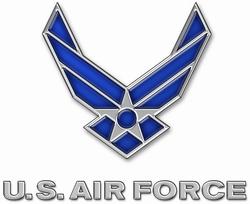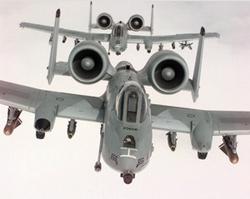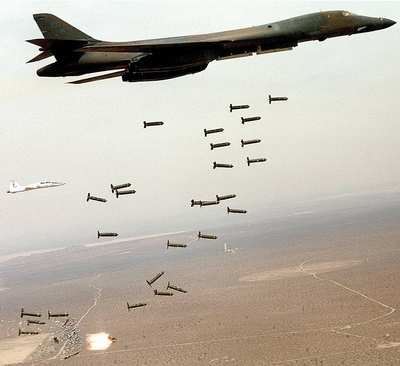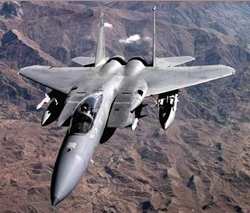No Time To Sit On Their Laurels
 Even
as deployed airmen return home from Operation Iraqi Freedom, Air
Force officials are focusing on what they need to do to reload the
service for the next contingency.
Even
as deployed airmen return home from Operation Iraqi Freedom, Air
Force officials are focusing on what they need to do to reload the
service for the next contingency.
According to Lt. Gen. Ronald E. Keys, deputy chief of staff for
air and space operations, the three priorities in reconstituting
the Air Force are people, units and the overall Air Force.
“In the people category, we need to give our people the
time to reunite with their families, take care of personal things
and decompress,” the general said. The service is also
committed to helping airmen get their career progression
requirements back on track, Keys said.
“We have to give them a chance to study for their
promotion exams and get them into professional military education
classes or other professional training,” he said.
“We’ll make sure they don’t lose those classes by
virtue of having answered the call to go to war.”
Unit reconstitution will consist of getting local training
programs back on track, restocking supplies, and repairing and
maintaining equipment.
At the Air Force level, Keys said senior leaders would have to
face challenges ranging from personnel management to completely
reloading the air and space expeditionary force rotation
schedule.
Ready For Anything
 “The AEF construct is a crisis-contingency
mechanism for scheduling people to (deploy),” he said.
“We froze AEFs 7/8 in place, added 9/10, then added parts of
1/2 and 3/4. There are a lot of people over there, and the AEF is
not in sequence.”
“The AEF construct is a crisis-contingency
mechanism for scheduling people to (deploy),” he said.
“We froze AEFs 7/8 in place, added 9/10, then added parts of
1/2 and 3/4. There are a lot of people over there, and the AEF is
not in sequence.”
Keys said he expects the AEF cycle to back on track by early
2004. In the meantime, the Air Force will weave together interim
AEF pairs to meet upcoming deployment requirements.
“We’ll take the (people who did not deploy) from
AEFs 5/6, 1/2 and 3/4, and package them into a temporary
AEF,” Keys said. “As we get the force reconstituted,
we’ll come off the interim AEF and start the normal rotation
with everyone back into an AEF window.”
The AEF Center at Langley Air Force Base, Va., is a key
component to the reconstitution effort, because they are the ones
charged with keeping track of people, equipment and deployment
requirements, the general said.
”The AEF Center is absolutely critical because they know
where all the people are and what the capability is,” he
said. “They have a tough job, and the world doesn’t
stand still. We still have requirements in the Pacific, (for) the
global war on terror and in the Balkans, so it’s not as
simple as just focusing on Iraq.”

It is the service’s commitment to meeting the challenges
of those and other potential requirements that are driving the Air
Force to reconstitute as quickly as possible, Keys said.
“The people of the United States expect us to be ready
when called upon,” he said. “The longer you wait to
reconstitute, the more difficult it becomes. For every day we lose,
down the line there’s some training event that’s been
missed.”
Surge Operation Needed
 Keys
said a highly coordinated “surge” operation would be
required to work through the training backlog caused by instructors
and equipment being deployed. Part of that coordination includes
working with the various major commands to address their unique
concerns and requirements.
Keys
said a highly coordinated “surge” operation would be
required to work through the training backlog caused by instructors
and equipment being deployed. Part of that coordination includes
working with the various major commands to address their unique
concerns and requirements.
“We have to go through this whole gamut -- people, units
and big Air Force,” he said. “You can’t do any of
them in isolation because everything you do in one place causes a
ripple effect. You have to coordinate; you have to have a policy
across the force.
“The end game, where we’re going, is to get back
into the AEF battle rhythm,” Keys said. “The AEF is the
way we do business in the Air Force. That’s the way we
provide forces to the combatant commanders.”
ANN expresses a special thanks to Master Sgt. Scott Elliott,
Air Force Print News
 ANN's Daily Aero-Term (05.07.24): Hazardous Weather Information
ANN's Daily Aero-Term (05.07.24): Hazardous Weather Information ANN's Daily Aero-Linx (05.07.24)
ANN's Daily Aero-Linx (05.07.24) Airborne 05.01.24: WACO Kitchen, FAA Reauthorization, World Skydiving Day
Airborne 05.01.24: WACO Kitchen, FAA Reauthorization, World Skydiving Day Airborne Affordable Flyers 05.02.24: Bobby Bailey, SPRG Report Cards, Skydive!
Airborne Affordable Flyers 05.02.24: Bobby Bailey, SPRG Report Cards, Skydive! Airborne 05.03.24: Advanced Powerplant Solutions, PRA Runway Woes, Drone Racing
Airborne 05.03.24: Advanced Powerplant Solutions, PRA Runway Woes, Drone Racing






